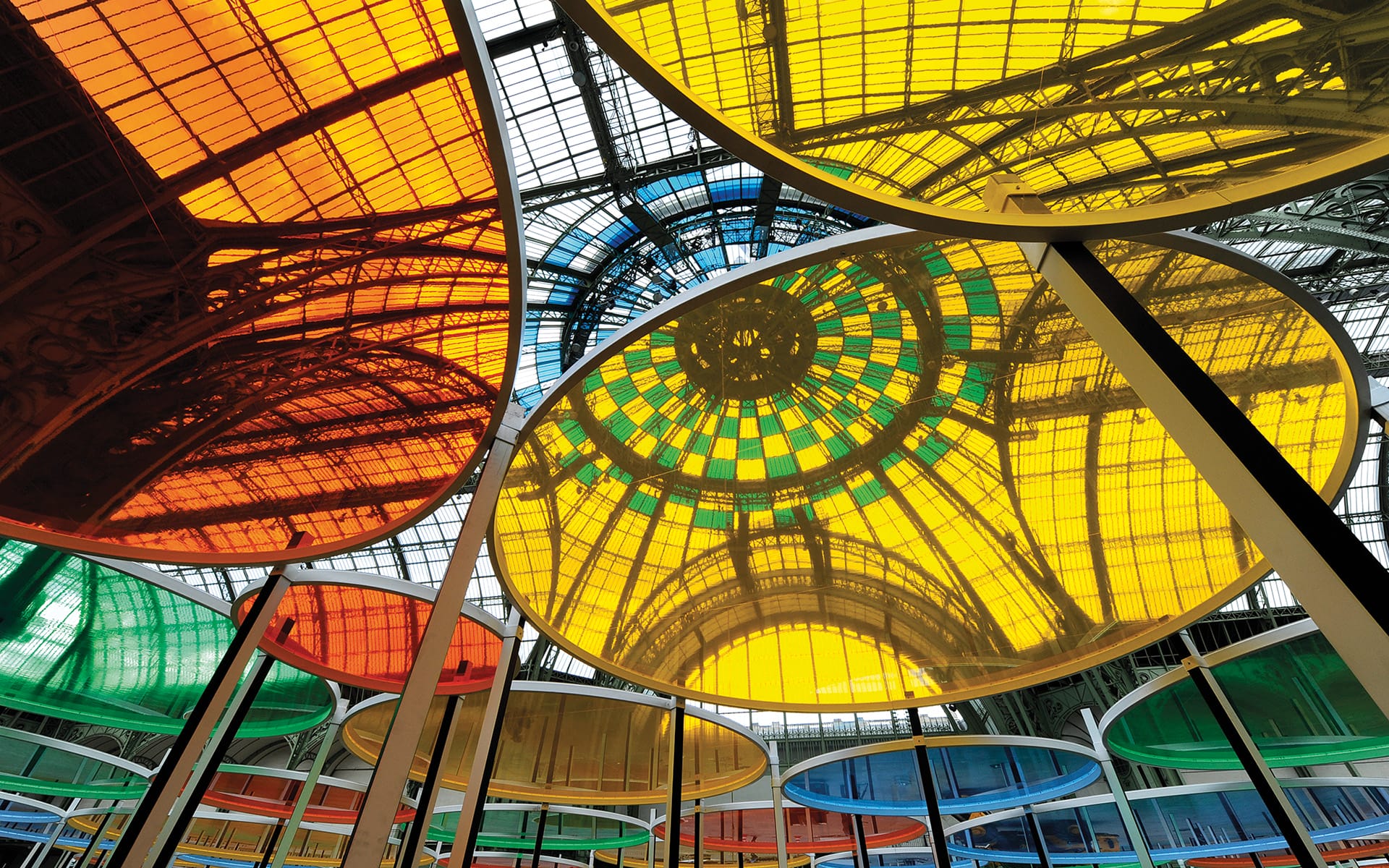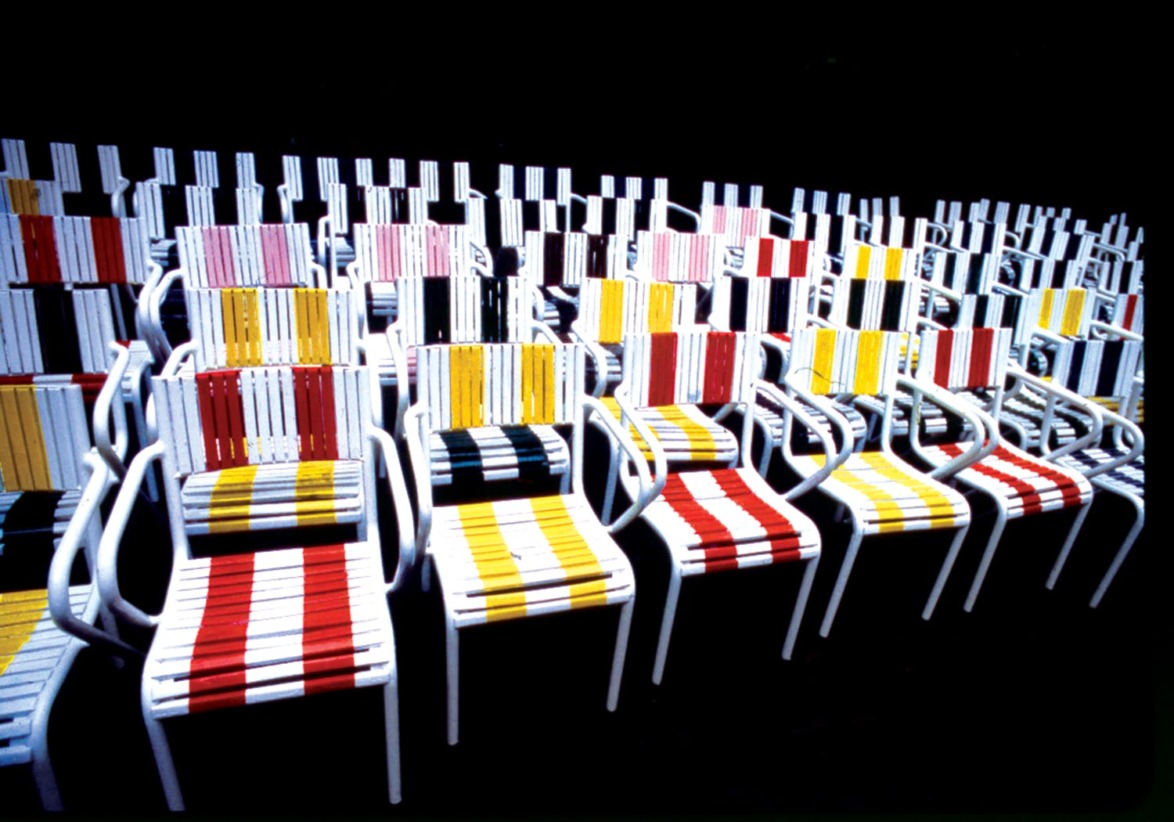8 Definitive Works from Daniel Buren’s Prolific Career
On the occasion of two of the French artist’s most extensive site-specific intervention to date, Galerie revisits highlights from his career of visually arresting works

Photo-souvenir : Painting-Sculpture, travail in situ, in “VI Guggenheim International,” Guggenheim Museum, New York, février 1971. Détail
Relatively unknown to American audiences at the time, Daniel Buren unveiled this 66-foot canvas inside the Guggenheim Museum’s rotunda during the Guggenheim International Exhibition; it was removed on the eve of the opening under pressure from other participating artists for blocking the view to their works.
This event inspired Buren to paste a facsimile of a Hans Haacke artwork, which had also been been refused for the same exhibition, directly on top of one of his own for a group show in Cologne in 1974. “If the German authorities wanted to destroy Hans Haacke’s work, they would have to destroy mine at the same time, and make this new censorship obvious. That’s what they did, and what led the public and all the other artists to witness censorship by destroying two works at the same time,” says Buren. “The controversies that follow such exactions make these exhibitions landmark events, which unfortunately almost always turn out to the advantage of the censors rather than the censured. On the other hand, the fierce and repeated polemics against the work Les Deux Plateaux at the Palais Royal turned out to be rather to my advantage, given that it is now one of the most visited places in Paris and therefore one of my most famous pieces.”


Photo-souvenir : Sculpture polychrome, travail in situ, Caféteria de la XXXIX Biennale de Venise, Juin 1980. Détail
Buren has exhibited at the Venice Biennale nearly a dozen times, even earning a Golden Lion for his installation at the French Pavilion in 1986. Yet the artist declares this rebellious 1980 work—a parade of cafeteria chairs decorated with his signature stripes—his favorite from the venerable fair. “Despite a new rule laid down for that session that no artist could exhibit outside, I decided to repaint—in my own way—all the chairs used for the cafeteria alongside the large International Pavilion in a multicolored scheme.”

Photo-souvenir : Les Deux Plateaux, travail in situ, cour d’honneur du Palais Royal, Paris, 1985-1986. Détail
Although he began painting stripes early in his career, Buren honed his use of the motif—most recognizable in this now-permanent landmark at the Palais-Royal in Paris—after discovering yards of cotton fabric with equal and alternating stripes at Marché Saint-Pierre in Paris. “There is no reason for the stripes per se; they are the result of a natural process that began when my work was developing,” he says. “The stripes became a pattern, a sign that I later called my visual tool.”

Photo-souvenir : Excentrique(s), travail in situ, Monumenta 2012, Grand Palais, Paris, mai-juin 2012. Détail
One of France’s most prestigious commissions, Monumenta offers a major contemporary talent the opportunity to implement a spatial artwork inside the Grand Palais’s nave. As the fifth such recipient, Buren constructed a colorful canopy of blue, green, orange, and yellow plastic disks. “There are many parameters for choosing colors. The very last one, the one you absolutely have to be wary of, is your own taste in the matter,” he says. “The ones that count are the way certain colors are perceived in a particular culture. In Japan, for example, alternating stripes of white and black or white and purple are signs of mourning, so if I use these two colors in a work and I have no intention of making any allusion whatsoever to mourning or death, my whole work will be read in a completely different way from the one I had in mind. Such a work would then find itself very strongly charged with a meaning from which it could not escape. Knowing this will enable you to eliminate (or accept) these colors with full knowledge of the facts, and thus avoid possible misinterpretations.”

Photo-souvenir : Daniel Buren, MaMO, Cité radieuse, Marseille, 2014
“For me, there is no such thing as a work without a location,” says Buren, whose work has been defined as ‘in situ’ since the late 1960s. “Since the beginning of my career, this practice allowed me not to use a studio. My studio, in fact, is the place where I am. Consequently, my studios are multiple, open, and public. I’m still experimenting.”

ArtyCapucines, 2022
While Buren’s graphic designs readily lend themselves to fashion and interiors, he refused offers until 2022, when he joined a prestigious group reinterpreting Louis Vuitton’s iconic Capucines bag. “A gifted painter or sculptor is very often (and this is no fault) a totally mediocre designer,” he says. “It was a great pleasure to work on this bag, and if it’s a success, it’s due to those who were able to interpret the requests I made of them with brio and simplicity. I also really enjoy working as part of a team, and this kind of commission makes it possible to collaborate in this way.”

Photo-souvenir : Spécularité : 2 Cabanes, bleue et jaune, explosées, éclatées, reflétées, diffusées, opposées, mélangées, démultipliées, écartelées, renversées, travail in situ, polycarbonate, vinyles, miroir verre, Alucobond, Le Bon Marché Rive Gauche, Paris, 2024. Détail
Buren opened 2024 with a multifaceted artwork inside Le Bon Marché in Paris, which will return to the famed department store on June 29. Next, Haltes Colorées, Travaux in Situ (2023–24) for Mitico, a series of site-specific installations, will animate Belmond properties in Cape Town, Rio de Janeiro, Mallorca, Venice, Florence, and the Tuscan countryside in collaboration with Galleria Continua.
“The situation is quite exceptional in terms of the locations offered, but the possibilities for implementing the work are closer to the particular and constant exercise that drives me, which consists of putting on one exhibition after another,” Buren says of the latter, which just unveiled its first iteration at Belmond’s Cape Town hotel, Mount Nelson. “The originality here consists of the demand to produce works that are all different but linked not only to the place where they are going to be shown, which is an intrinsic part of their identity, but also with places that are strongly linked to each other, partly because of Belmond, but also by the beauty of each of the buildings and because of the different and sublime environments in which they are set. The common thread will be the use of color in all its forms.”
A version of this article first appeared in print in our 2024 Spring Issue under the headline “Milestone: Daniel Buren.” Subscribe to the magazine.

